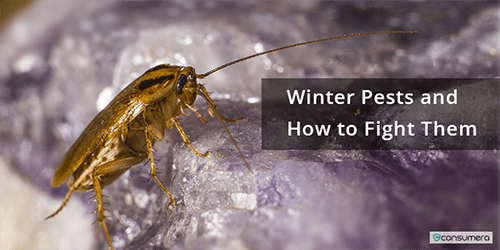Winter is finally here, and it’s time for hot cocoa, cider, and Christmas cheer! But just as us homeowners prefer to warm up by a fire while it snows, winter pests like to keep warm too! With temperatures dropping outside, all sorts of pests and critters will come to seek refuge in your warm and cozy home. The habits of these winter pests can not only cause illnesses to you and your family but also wreak havoc on your home.
So while you prepare to clear up piles of snow from your driveway, also gear up to get rid of the creepy crawlies that intend to invade your home for warmth and shelter.

House mice are the most common winter pests invading American homes. House mice are quite tiny and can fit through small gaps and crevices, making them very difficult to trap. They prefer dark and secluded places like your basement or attic.
Mice can be a nuisance, especially to garages that have drywall. They eat through the drywall to create accessible pathways to and fro your house. House mice are the usual culprits of household electrical fires because they chew up the electrical wiring.
House mice will eat and contaminate all your food. They are notorious carriers of diseases like salmonella and tapeworms. So make sure that all your food is packaged and sealed tightly.
Thankfully, you can catch your house mice using traditional baits and traps if they have not reached large numbers. Seal all cracks with caulk or steel wool, as house mice can fit through gaps as small as a dime. Regular inspection of the house for mouse fecal matter and gnawing marks on boxes will indicate where your house mice like to dwell.
Although Norway rats come from the same family of pests as the house mice, they are far more dangerous. First, they are more aggressive and bigger as compared to the house mouse. Second, their bite can be quite painful, and spread diseases like rabies. If a Norway rat bites you, get an anti-rabies shot from your nearest medical clinic immediately.
What makes them dangerous to your home is how relentless they can be when trying to obtain food and water. Norway rats are capable of chewing through plastic and lead pipes in search of water. You will end up with leakages in your home, which over time, result in costly infrastructural damage.
Rats are dangerous and known for spreading diseases like jaundice, rat-bite fever, and cowpox virus. These rodents tend to live in grimy areas and sewage. Their bodies amass a lot of grime and pathogens, which they spread as they drop fecal matter everywhere and nibble at your food. You need to keep a lookout for grease stains on your walls, which are indications of a rat infestation in your home.
Another common irritant, German cockroaches are notoriously stubborn to get rid of. The German cockroach is the most common species of roach in the world. While they do not bite, their appearance unnerves a lot of people. They are, however, highly capable of contaminating your food and surroundings, leaving you with respiratory diseases, allergies, and illnesses from various pathogens.
Roaches hitch a ride on your grocery bags and second-hand electronics. They usually prefer to dwell in small, closed spaces with access to food and moisture. They can generally be found in your washrooms and kitchens.
Simple methods like spreading cockroach repellent are effective for small populations of roaches. Make sure you place these repellents in spots you usually see these uninvited guests. Other steps are to vacuum your home regularly and dispose of trash as soon as possible.
If you have a major German cockroach infestation in your hands, it’s advisable that you leave the task of extermination to the professionals.
Spiders are quite scary to look at in general but, the Brown Recluse Spider is one to be feared in the winters. The brown recluse spider has a powerful bite that won’t kill you but will be quite painful. The bite can still be fatal if the victim has an allergic reaction to the venom.
The first thing to do if a brown recluse spider bites you is to call in emergency medical services. The next step is to clean up the wound. Because the brown recluse spider looks quite similar to other dangerous species of spiders, try to take a picture. The doctors will have an easier time identifying it and quickly diagnosing the appropriate treatment.
As the name suggests, the Brown Recluse spider prefers secluded and dark places. It spins webs in your attic, basement, within cardboard boxes, and prefers to be left alone. The brown recluse spider may make a home inside baseball mitts, shoes, clothes, etc. Store your footwear in plastic boxes to prevent the brown recluse spider from making them it’s home. If you think that there’s more than one spider in your home, it’s paramount that you call in a pest control agency to get rid of them safely.
Tackling pests at any time of the year is a difficult task, but it gets harder in the cold season. You already have your hands full, keeping your home warm, clearing up the snow from your driveway, etc. Laying traps and outsmarting the winter pests is unnecessarily hard work. So, why not leave the pest extermination to the professionals?
Invest the time you have on celebrating Thanksgiving, Christmas, and the New Year! Explore all the top pest control agencies in the United States only on www.Consumera.com. It’s the one place where the top pest control agencies are ranked and reviewed by your fellow consumers. Based on your budget, you can gauge and compare agencies.
Our top 3 picks



